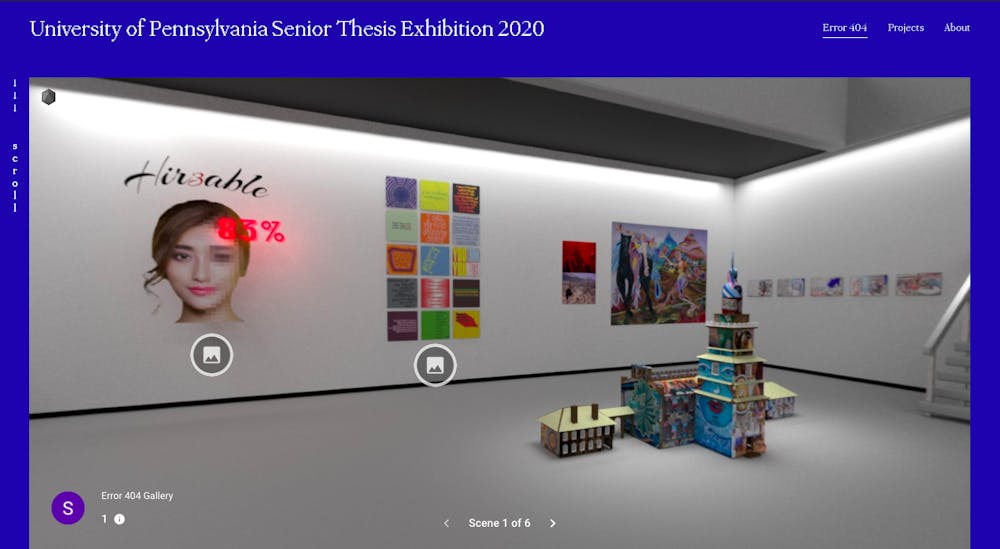
Although Fine Arts seniors had to clear their physical studio spaces, their theses have been rendered in a 3D modeled space. (Photo from www.error404exhibition.com)
For students and professors in Fine Arts programs, the transition from studio-based to virtual learning and instructing has been a uniquely difficult experience.
Unable to return to Penn since on-campus operations were shut down in mid-March, Fine Arts students and professors were forced to create artwork and instruct classes without access to the University's high-quality multi-media equipment.
Rising College junior and Fine Arts major Alaina Chou said since the University shifted all courses to online formats while many students were off-campus for Spring Break, many Fine Arts students were unable to return to campus to pick up their supplies needed to create portfolio work.
Chou was enrolled in FNAR 123 Drawing 1 during the spring semester, a course she said was originally taught using a variety of art mediums.
“A lot of people just had printer paper and number two pencils to work with," she said.
Chou also said the remote learning transition led her course format to change dramatically, replacing the normal bi-weekly three-hour studio sessions with a 15-minute, one-on-one Zoom call with the professor each week to monitor work progress.
Her professor suggested students work on their assignments at the usual class times, but Chou said she and other students found that to be difficult since they were no longer in a studio environment.
“It was more [about] finding time when I could,” Chou said. “I couldn’t get myself to sit down [for] three hours of time on my own and draw without being surrounded by people who were doing the same thing.”
Similar to Chou's professor, professor Avery Lawrence, who taught FNAR 264 Art, Design, and Digital Culture in the spring semester, altered the ways in which he taught the class. FNAR 264 also consists of two weekly, three-hour classes that take place in a computer lab, which Lawrence said he knew would not translate well to an online learning format.
"There was no way I personally would watch a three-hour recorded or live session of my professor just talking on a webcam," Lawrence said. "So I started thinking, ‘What stuff do I like to consume on the internet and learn a lot from?’”
Lawrence said he began creating shorter 10 to 15 minute lecture videos, designed to be more consumable for his students.
A challenge he said he faced was being unable to use the University's computer lab facilities, which has computers equipped with downloaded design software, because some students in his class did not have the technological capabilities to download the programs on their personal devices.
Instead of requiring each student to download these programs, which Lawrence said may be difficult for some students, he designed projects in a way so that all of his students could complete them without downloading the programs.
For graduating seniors in the Fine Arts major, the spring semester was particularly challenging as their senior exhibition was canceled and they were told to clear out their individual studio and showcase spaces.
The process of clearing out the studio was a “turbulent time,” said 2020 College graduate Eliza Culp, as each space in the studio represented the culmination of four years of work.
In their final year at Penn, graduating Fine Arts majors create their body of work in a physical studio space and showcase their final thesis in an end-of-year exhibition, which was originally supposed to be unveiled on March 27 in the Meyerson Gallery.
After the in-person exhibition was canceled, however, 2020 College graduates and Fine Arts majors Stara Diamond and Natalia Cabalceta created 3D-modeled space renderings of the Meyerson Gallery and digitally-recreated versions of each senior's portfolio work.
“[Fine Arts seniors] had so many late-night conversations with [Diamond and Cabalceta] about how we envisioned things, how we wanted them, and specifying everything to them,” Culp said. "I owe my life to them at this point."
The virtual exhibition, titled "Error 404: A Virtual Fine Arts Senior Thesis Exhibition," showcases the students' multimedia creations inside a digital simulation of a gallery. The exhibition began on May 17 and will remain online until Sept. 1.
The Daily Pennsylvanian is an independent, student-run newspaper. Please consider making a donation to support the coverage that shapes the University. Your generosity ensures a future of strong journalism at Penn.
Donate







